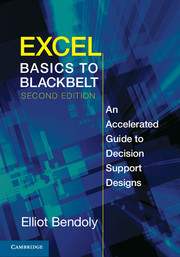Book contents
- Frontmatter
- Contents
- Associated Links
- Preface
- Section 1 Getting Oriented
- Section 2 Harvesting Intelligence
- Section 3 Leveraging Dynamic Analysis
- Section 4 Advanced Automation and Interfacing
- 11 Visual Basic Editing and Code Development
- 12 Automating Application Calls
- 13 Guided and User-Friendly Interfaces
- Glossary of Key Terms
- Appendix: Shortcut (Hot Key) Reference
- Index
13 - Guided and User-Friendly Interfaces
Published online by Cambridge University Press: 05 August 2013
- Frontmatter
- Contents
- Associated Links
- Preface
- Section 1 Getting Oriented
- Section 2 Harvesting Intelligence
- Section 3 Leveraging Dynamic Analysis
- Section 4 Advanced Automation and Interfacing
- 11 Visual Basic Editing and Code Development
- 12 Automating Application Calls
- 13 Guided and User-Friendly Interfaces
- Glossary of Key Terms
- Appendix: Shortcut (Hot Key) Reference
- Index
Summary
As you've probably guessed by now, decisions can become increasingly complex as we increase the number of variables and constraints to maintain reality and practicality in our decision-making process. Similarly, the ability to concisely provide visualizations of what is possible and what is ideal (and, conversely, what isn't) becomes increasingly challenging. Given this complexity and the perceived need in industry to nevertheless pursue means of assisting people in decision making, the concept of the dashboard has come into being and continues to gain popularity.
A dashboard, from a general decision-making perspective, is basically a computer interface that allows individual users to simultaneously view various depictions (that is, presented structures) of data and information, as well as various subsets of data (that is, content) relevant to a particular task and user context. For example, Figure 13.1 shows four dashboards that I’ve personally put into use for research and consulting purposes in the recent past.
Two of these are highly oriented toward geographic (specifically, logistics) tasks; the other two are designed with project management tasks in mind. You’ll notice that each of these consists of multiple frames and multiple control- and form-based interfaces. Some make use of parameterization forms more so than others. Some make use of graphs and charts predominantly, whereas others make rich use of tables with key indices summarized. All of them were designed as applications that could function through the use of Excel alone, and are highly mobile from a distributional perspective.
- Type
- Chapter
- Information
- Excel Basics to BlackbeltAn Accelerated Guide to Decision Support Designs, pp. 359 - 380Publisher: Cambridge University PressPrint publication year: 2013



